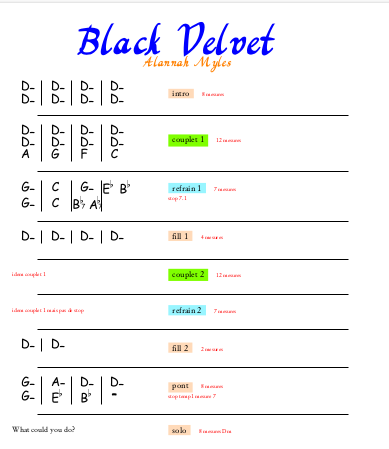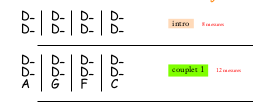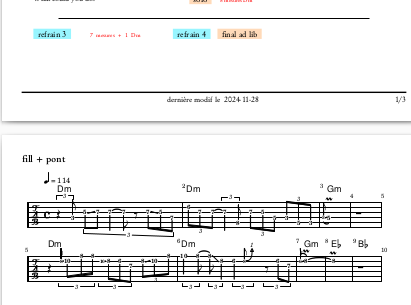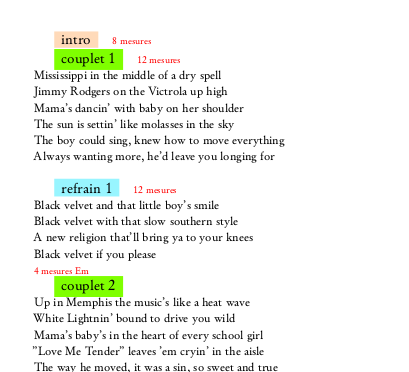Overview
This is a personal project, the target is to help me generate and maintain synthetic songbooks, that I can use when playing with my amateur pop band.
Standard music notation looks something like this :

In pop music, this can be quite hard to follow, you may have 96 times the same chord, which ends up in a music sheet of 5 pages with the same thing. When you play, you cannot turn the page, so you want a synthetic view, with easy to visualize patterns ( ie verse, pre-chorus, chorus, bridge, ...), with bar number, and annotations.
The goal is also for the band, not just for the guitar player, to have a short way to communicate about the song articulations, the breaks, and so on. Of course this does not replace the need to learn the song by other means ( real score, learn by ear, or any other way), and it does not replace having to practice your instrument with a full score support, or by ear.
The targeted goal is to have pdf files that you can either print or see on a tablet, such as :
one A4 page

easy to follow grid notation, one cell per bar

a music sheet snippet, for the bridge

lyrics are in sync with the score

This document has the following sections, that hopefully help to understand the :
- what do we want ( the specifications )
- the detailed design ( how is that written, how to maintain it )
- the user manual ( how to use it )
- the installation manual ( how to install it )
other stuff
Other than providing songbooks, this project is also for me a fun stuff :
- a fun way to practice rust
- learn leptos to have a web application, with client side only : no dev on server side
- play with rust mdbook
- deploy doc with github
gh-pages
inputs and outputs requirements
| Requirement | Description |
|---|---|
| pdf output | the tool output will be pdf files |
| wav output | the tool will output wav files when needed |
| input | the input are text files |
export requirements
| Requirement | Description |
|---|---|
| delivery dir | all export files (pdf and wav) will be available in one dir |
| google drive | export to google drive |
dependencies requirements
| Requirement | Description |
|---|---|
| os | OS and required tools |
interface requirements : two user modes
| Requirement | Description |
|---|---|
| text editor | text editor mode |
| web mode | web browser mode |
dependencies requirements
| Requirement | Description |
|---|---|
| os | OS and required tools |
rendering requirements :
what to find in the pdf output
| Requirement | Description |
|---|---|
| sections | a song is structured as sections |
| refs | a section can be a reference to another one |
| musicsheet | insertion of music sheet snippet |
| tempo | show song tempo |
| time signature | show time signature |
| color | coloring of sections |
| bar numbering | show numbering of bars |
| time | show time on bars |
| book | definition of book |
| last modified time | the last modified time of a song will be rendered |
| lyrics | lyrics will be rendered, synced with the sections |
| coherence | tempo, signature and bar numbers will be coherent in the doc |
| table | the section chords will be rendered as tables |
| chord symbol | the chords in a table will be rendered in a standard way |
| chords per bar | render up to 2 chords per bar |
| line repeat | show line repeats to make rendering smaller |
| text rendering | text rendering will have a lot of features |
wav files
whenever a piece of music sheet is present in the song, it will be possible to generate a wav output for that piece.
input
all inputs are readable text files. It will therefore be possible to put them in a git repo and manage the life of these files
two edit modes
there will be two modes : the local and the web mode
output export
provided correct configuration, it will be possible to export the pdf outputs to a google drive
web mode
in web mode, you edit the remote files via a web interface, you trigger the generate of the pdf file by clicking a button on the web interface
Operating System
the software will run on standard ubuntu. There is no requirement that it runs on windows.
Delivery Directory
All output files will be available in one directory.
google drive
A command will allow to upload all pdf files to a google drive location, if correct credentials are provided
pdf output
the tool output will be pdf files
we want to be able to print a songbook, and also to download it on a tablet, and be available without internet connection
wav files
whenever a piece of music sheet is present in the song, it will be possible to generate a wav output for that piece.
input
all inputs are readable text files. It will therefore be possible to put them in a git repo and manage the life of these files
two edit modes
there will be two modes : the local and the web mode
local mode
in local mode, you have access to a machine where you cloned the repo that has the songs, and you also cloned the repo that has the code of the tool. (currently they are in the same repo)
it requires that you have some computer science knowledge, as you will have to install a few things, edit the data files and run the tool
OS
the software will run on ubuntu. There is no requirement that it runs on windows.
output export
provided correct configuration, it will be possible to export the pdf outputs to a google drive
web mode
in web mode, you edit the remote files via a web interface, you trigger the generate of the pdf file by clicking a button on the web interface
requirements on rendering the pdf output
tempo
the tempo will be shown, in BPM. There is one tempo for the whole song, if the real song has different tempos, this will not be rendered
sections
what we call a section is what you naturally see in a song : verse, chorus, pre-chorus, bridge, intro, ...
- it will be possible to define new sections
- sections will be associated with colors
- each section has associated lyrics
time signature
time signature will be shown in the output. There will be one time signature for the whole song, except if a bar is marked with another time signature
music sheet snippet
it will be possible to have music sheet snippets in the rendered output pdf file. This way we can show the solos, riffs, gimmicks....
coherence
the sections in the grid rendering will be in coherence with the sections in the lyrics. This mean that if we have, for instance, a song with verse-1, verse-2, pre-chorus-1, chorus-1, we will find these sections in both rendering
grid
the chords will be shown as a grid, with 4 columns, one grid per section
chords symbol
the chords will be shown with the A...G symbols ( not Do Ré Mi...).
- the minus symbol will show the minor
- 7 for 7 chords
- flat and sharp
- m7
- sus chords
- 5 chords
- 7M will be show as a triangle
- diminished chords as small circle
the size of a cell for a chord will not change, this means that a C chord rendering will take as
much width as a C#m7, so all cells have same size
chords per bar
there will be one or two chords per bar, for visibility reason. if a bar has more than 2 chords, this will be in annotation
line repeat
it will be possible to specify a line repeat. In this case, we will have a symbol that shows the line has to be played this number of repeats.
the line repeat value will be either 2, 3 or 4.
the bar count numbering and time will have to be coherent with the time repeat
text rendering
text rendering will have these features :
- foreground color
- background color
- internal and external links
- italic, bold, and other fonts
- foot notes
local mode
in local mode, you have access to a machine where you cloned the repo that has the songs, and you also cloned the repo that has the code of the tool. (currently they are in the same repo)
it requires that you have some computer science knowledge, as you will have to install a few things, edit the data files and run the tool
look at installation procedure for configuring the machine.
web mode
Generate the outputs
Installation
Overview
There are many ways to achive that. We could use a word processing tool, such as Microsoft Word, latex, lilypond, musescore or even sketch with a pencil on a paper and take a picture.
but none of these respect our requirements, so this is our design :
text : latex
textual information, such as lyrics, comments, annotations,... are captured in latex files. This way we have the formating flexibility we want.
We could have done everything with latex, except from the music sheet, by writing a new latex class. But choose to limit latex, for the user, to the capture of text.
music sheet : lilypond
Music sheet snippets are captured in lilypond files. We will be able to output the partitions of solos, bridges, chord diagrams, ... and insert them in the pdf output file. This will also allow to export wav files, because lilypond has a midi export.
there are other tools to do that, but lilypond is way superior, at the cost of some complexity. We think it is worth the cost.
master file
A master file will contain the description of the sections, the tempo, and all other informations.
This master file will have a fixed name : song.json.
master tex file
A master tex file will contain the latex information. This file is named body.tex.
This is not the main.tex file, that contains the
document class, this file is generated.
book
A book is only a list of songs, with a book title. It is defined in a json file
file organization
Each song is contained in one directory. It will have :
song.json: the master filebody.tex: the master tex filelyricsdirectory : contains the lyrics of the song, one tex file per section- additional regular tex files. You just import them as you would do
- additional lilypond files (.ly extension).
The information to name the pdf file are inside the song.json master file, but, for sake of readability,
we will use :
songdir root
+--- artist 1
+--- song 1
+--- song.json
+--- body.tex
+--- ... other tex files if any...
+--- ... lilypond files if any ....
+--- lyrics
+--- lyrics tex fils
+--- song i
+--- song N
.... subtree of song 2
+--- artist i
+--- artist N
+--- a song
... files
+--- another song
... files
bookdir root
+--- book1.json
+--- ...
+--- bookN.json
file tree
all songs will be under a root directory : the songdir directory.
all books will be under a root directory : the bookdir directory. Each json file in this directory defines a book.
omake
the omake build tool omake, not to be confused with IBM omake tool, is a make tool that looks like make, but is actually much superior :
- it does not have the dependency issue, see recursive make considered harmful, which prevents from efficiently use make in big projects
- dependencies are built on checksum of files, not on dates, so it does not matter if you regenerate files before running a build
- a lot of other stuffs... not discussed here
we want a build system because building a pdf or a wav file can be long, and we are going to iterate a lot when capturing a new song, especially with the lilypond files.
the tools
we have three tools, written in rust, in this project :
songbook: this is a code generator- for web only :
songbook-serversee server - for web only :
songbook-clientsee client
workflow
this is :
- run
songbook <songdir> <bookdir> <builddir> ( cd builddir && omake )
the songbook tool will
- read all the songs from the
songdirtree - read all the books from the
bookdirtree, - generate the OMakeroot and OMakefile in the
builddirtree - genere some ressource files at the root of the
builddirtree
you can then run omake.
code generation
lilypond files
input
master json
We use serde_json to automate reading from json file to a rust struct, this is documented here :
available section types
The list of valid sections is built at compile time, it is read with serde json from this file : others/texfiles/sections.json
To modify the available section types, just change the file and rebuild.
lilypond
book
code generation
the songbook tool is a code generator. Syntax is :
songbook <songdir> <docdir> <builddir>
it takes inputs :
songdir: the root dir of songsbookdir: the root dir of books
and will generate code in builddir
when and why do we need to generate ?
we could have used omake scanner facility to replace some features, but it would have been tricky.
We need to regenerate whenever a master song.json has changed, or a song was added or removed, so that
the makefiles are up-to-date. The action of generating is a few ms so in our workflow there is no point in trying
to optimize that, compared to the generation of pdfs that is 100 times longer.
So the answer is : generate each time you build, it is harmless.
thanks omake
Omake uses digest of files to know if a target needs to be rebuild. So when you regenerate you will have source files that are more recent than the output pdf file, but omake will not rebuild the target.
tree structure
all files are generated in the builddir tree. No file is generated in the source directory : code generate leaves the sources unchanged.
<builddir>
OMakeroot
OMakefile
+--- delivery
| +--- .... all the delivery files : pdfs and wav
+--- songs
| +--- artist 1
| | +--- song 1
| | | +--- OMakefile
| | | --> ... generated files : main.tex, ...
| | | --> ... all vmount files...
| | | --> ... files generated by the build
| | +--- song N
| | ....
| +--- artist N
| +--- songs....
+--- books
+--- book 1
| +--- OMakefile
| --> ... generated files : main.tex
| --> ... files generated by the build
+--- book N
vmount files
omake has the vmount feature : any file used as a dependency in an OMakefile is copied from the source directory to the build directory, and this is done each time you run the build. So it looks as if the srcdir is mounted in the builddir.
For that to work, source files have to be declared in the OMakefile, and this is done because they are declared in the master json file. Other mounted files added automatically are :
- body.tex ( we have to have it, so it does not need to be declared in the master json file )
- the tex lyrics ( one per section ) : this list is generated
the code generator will generate :
files for running omake :
latex files
OMakeroot
omake requires to have a OMakeroot file, (see omake doc) the code is a handle bar template, others/makefiles/omakeroot
root OMakefile
this is the root makefile. Here we define some phony targets, the code is a handle bar template, others/makefiles/root_omakefile
song OMakefile
this is the makefile you find in every song directory, the code is a handle bar template, others/makefiles/omakefile
book OMakefile
this is the makefile you find in every book directory, the code is a handle bar template, others/makefiles/omakefile_book
main.tex
this is the main.tex file, where the latex document is declared. This is file is the input of the lualatex command.
the code is a handle bar template, others/texfiles/main.tex
We have here the input of other generated files, and the input of the user's code : body.tex
preamble.tex
this is where we define the latex preamble, that is the require of all latex packages we need. others/texfiles/preamble.tex
sections.tex
This is where, for each section type xxx, we define the latex macro \songbooksectionxxx and \\songbookcolor
that can be reused in latex code
others/texfiles/sections.tex
data.tex
This is where, using the data from master file song.json, latex macros are defined :
others/texfiles/data.tex
\songtitle\songauthor\songtempo\makesongtitle: will format the string\songlastupdate\songbooksongstruct: this one has the sections of the song, it is the one you want to put in yourbody.texfile
chords.tex
see the fonts section
Our design is to define our fonts to display chords, so there will be one glyph per chord, for instance D flat 7 will be one glyph.
In this file we define marcros that map chords to glyphs : others/texfiles/chords.tex. For instance, we have for D flat 7 :
\newcommand\chordDfsept{{\songbookfontflat\fontsize{18pt}{18pt}\selectfont R ~ }}
fonts
we have our own fonts to display chords, each chord is a glyph
birdfont
we use the birdfont tool to edit the fonts. This tool has a commercial and a SIL open font license,
that you can use for free.
capture fonts
use birdfont to load and modify a font.
all glyphs cannot be in one font, so we split them in three fonts :
software/fonts/songbook.birdfont: the fonts for chordssofware/fonts/songbook_flat.birdfont: the fonts for flat chordssoftware/fonts/songbook_sharp.birdfont: the fonts for chords
For each font, we have, from letter A :
- major chords (A => G)
- minor chords (H => N)
- 7 chords ( O => U )
- minor 7 chords ( V => b )
- 7 major chords ( c => i )
- diminished chords ( j => p )
- suspended chords ( q => w )
export fonts
use (Ctrl-e) menu (export fonts), it will export the fonts to ttf files.
make them available
the pdf generator lualatex will look for additional fonts in $HOME/.fonts, so copy the ttf files there.
Other tools like LibreOffice may look for the fonts in other locations, read the doc for these tools
code generator
the mapping between chords and fonts is done in software/others/texfiles/chords.tex.
if you change the organization of chords/glyphs/fonts, don't forget to update this file
For instance, we have for D flat 7 :
\newcommand\chordDfsept{{\songbookfontflat\fontsize{18pt}{18pt}\selectfont R ~ }}
This is the songbook_flat font, so using letter R in our example we will have the wanted glyph :

@todo : finish writing the fonts
We use the same mechanism for the pause and repeat glyphs.
web
We will have web pages delivered, but with no web server.
no web server ?
Well, no developement of a web server, we will only have nginx running, and using a nice feature of nginx : the ability to
trigger sh scripts. This will allow us to have post actions, the two main ones are :
- trigger a build
- write a source file
this feature is configured in the /etc/nginx/sites-enabled/songbook.conf config file of nginx, in which we have :
location ~ (\.sh)$ {
types { application/json sh; }
gzip off;
root /var/www/songbook/scripts;
autoindex on;
fastcgi_pass unix:/var/run/fcgiwrap.socket;
include /etc/nginx/fastcgi_params;
fastcgi_param DOCUMENT_ROOT /var/www/$server_name/scripts ;
fastcgi_param SCRIPT_FILENAME /var/www/$server_name$fastcgi_script_name;
fastcgi_param QUERY_STRING $query_string;
}
web rendering
We will do that with rust-leptos create, that allows to write code in rust, that is translated to javascript and runs
in the browser : there is no server side code.
why ?
just because in our workflow, we don't really need a web server. We just need to trigger omake to build the outputs,
and
songbook user and www-data
Let's assume the tool is installed under songbook user.
the web server runs under www-data user, has no home directory, and has no right to change the songbook user files.
The only thing www-data can do is run the request.sh script in the /var/www/songbook/scripts directory
client web browser
|
+--> action --> http transfer --> nginx server
|
request.sh <-------------------------------|
|
+---> push request ( songbook-client running under www-data )
|
ZMQ messaging service
|
+---> songbook-server running under songbook user
polls the request
+---> action taken
ZeroMQ
this is free, easy to use and performant messaging library. There is a rust crate for that, and no server to configure.
server
client
web frontend
rust leptos
ace.js
setup
mdbook / cargo doc
mdbook
we use mdbook to generate the document you are reading
cargo doc
we use cargo doc to generate the documentation of the rust code source
deploy to github.io
we use github actions to deploy this documentation
mdbook / cargo doc
it does not seem that these tools were designed to work together, so, in order to have cargo doc generated files
inside the mdbook doc, you will see this file in .github/workflows/main.yml action :
- name: Build Book
run: |
cd doc/srs
mdbook build
- name: Build cargo doc
run: |
( cd software && cargo doc )
src=software/target/doc
target=doc/srs/book
mkdir -p $target
cp -R $src/static.files $target/.
cp -R $src/songbook $target/.
cp -R software/others $target/.
find $target/others -type f | while read f ; do echo $f ; cp $f $f.txt ; done
basically we :
- copy the rust doc generated html files in the mdbook generated tree.
- copy other files we want to see
- copy some files with the extension
.ext, so that they can be rendered